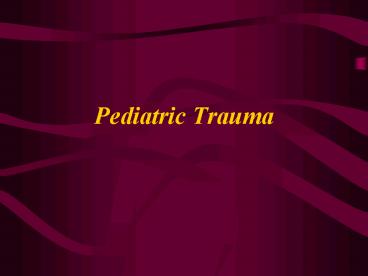Pediatric Trauma - PowerPoint PPT Presentation
1 / 34
Title:
Pediatric Trauma
Description:
Neck over-extension: obstruction ... ET tubes wind up in right mainstem ... Tenderness, edema, guarding, inconsolable crying = fracture until proven otherwise ... – PowerPoint PPT presentation
Number of Views:286
Avg rating:3.0/5.0
Title: Pediatric Trauma
1
Pediatric Trauma
2
Trauma
- 1 killer of children after neonatal period
- 50 of childhood deaths
3
Pediatric Trauma
- Same priorities as adults
- ABCs first
Children are not just little adults!
4
Airway
- Anatomy increases obstruction risk
- Large head
- Short neck
- Small mandible
- Large, posteriorly-placed tongue
5
Airway
- Poor, absent mouth breathing ability
- Neck over-extension obstruction secondary to
high glottis - Good anterior jaw displacement important
6
Airway
- ET tubes wind up in right mainstem
- Secure intubated childs head in neutral
position avoid extubation - Pass gastric tube early decompress stomach
7
Breathing
- Increased respiratory rate
- 30/min ? normal for small child
- Slowing rate impending arrest
8
Breathing
- Small thorax
- Transmitted breath sounds
- Misleading findings on auscultation
- Inspection, palpation more reliable
9
Breathing
- Diaphragm breathers
- Pliant chest walls
- Weak accessory muscles
- Limited respiratory reserve
10
Breathing
- Respiratory Failure Leading Cause of
Pediatric Cardiac Arrest
11
Circulation
- Small blood volume
- Rapid control of blood loss essential
- Good initial compensation for hypovolemia
- Sudden onset of irreversible shock
12
Circulation
- BP monitoring
- Poor method
- To assess perfusion, check
- Rate, quality of peripheral pulses
- Skin color, temperature
- Capillary refill
- Level of consciousness
13
Circulation
- Silence is not Golden
14
Shock Management
- 100 Oxygen
- Assist ventilation as needed
- Keep warm
- MAST
- Legs only initially
- If abdomen needed, intubate/ventilate
15
Shock Management
- Fluid Resuscitation
- LR in 20cc/kg boluses
- Reassess, reassess, reassess
- Repeat boluses as indicated by response
- Warm fluids if possible
- Gastric tube placement
16
Head Trauma
- Major cause of pediatric trauma deaths
- Intracranial hematomas less common
- Diffuse axonal injury, edema more common
- Outcomes better than in comparably injured adults
- Treat aggressively
17
Head Trauma
- Evaluate for increased ICP
- AVPU
- Pupils
- Vomiting
- Dysconjugate eye movement
- Cushings response
18
Head Trauma
- Control airway
- Protect cervical spine
- Controlled hyperventilation (10 breaths/min above
normal) - Ensure adequate shock resuscitation
Isolated head injury usually does not cause
shock!!
19
Spinal Trauma
- Rare in pediatric patients
- Usually high C-spine dislocation
- C-1, C-2
20
Spinal Trauma
- Suspect in same situations as adult
- Sudden deceleration
- Head, face injuries
- Decreased LOC in trauma
- Absence of good history
21
Spinal Trauma
- If you think about spinal immobilization, do it!!
- Resist temptation to pick up child, run
22
Chest Trauma
- Second leading cause of death after head trauma
- Primarily blunt
- High incidence of associated head, extremity
injury
23
Chest Trauma
- Pediatric thoracic wall pliant
- Rib fracture, flail chest rare
- Severe intrathoracic trauma can occur without
fracture
24
Chest Trauma
- Limited respiratory reserve
- Trauma poorly tolerated
- Recognize, intervene early
25
Abdominal Trauma
- Most common form
- Primarily blunt
- Spleen, liver Most common injuries
- High, broad costal arch
- Relatively larger organs
- Poor abdominal muscle development
26
Abdominal Trauma
- Mechanism of injury
- Unexplained hypovolemic shock
- Tenderness
- Increased abdominal girth
- Intra-abdominal hemorrhage until proven otherwise
- Could be gastric distension
27
Extremity Trauma
- Never warrants attention before head, chest,
abdomen injury
28
Extremity Trauma
- Most common complication neurovascular injury
- Especially common in supracondylar areas of
humerus, femur
29
Extremity Trauma
- Evaluate distal extremity for
- Pulses
- Skin color, temperature
- Motor, sensory function
- Capillary refill
30
Extremity Trauma
- Unique injuries
- Greenstick fracture
- Tenderness, edema, guarding, inconsolable crying
fracture until proven otherwise - Epiphyseal plate fracture
- Injuries near bone ends
- ? Growth problems
31
Burns
- Pediatric patients
- 50 of burn admissions
- 33 of burn deaths
32
Burns
- Large body surface area increased
- Fluid loss
- Heat loss
33
Burns
- Immature immune system
- Increased infection complications
- Small airways
- Decreased respiratory reserve
- Increased complications of airway burns
34
Burns
- Pediatric Burns
- Possible Child Abuse































